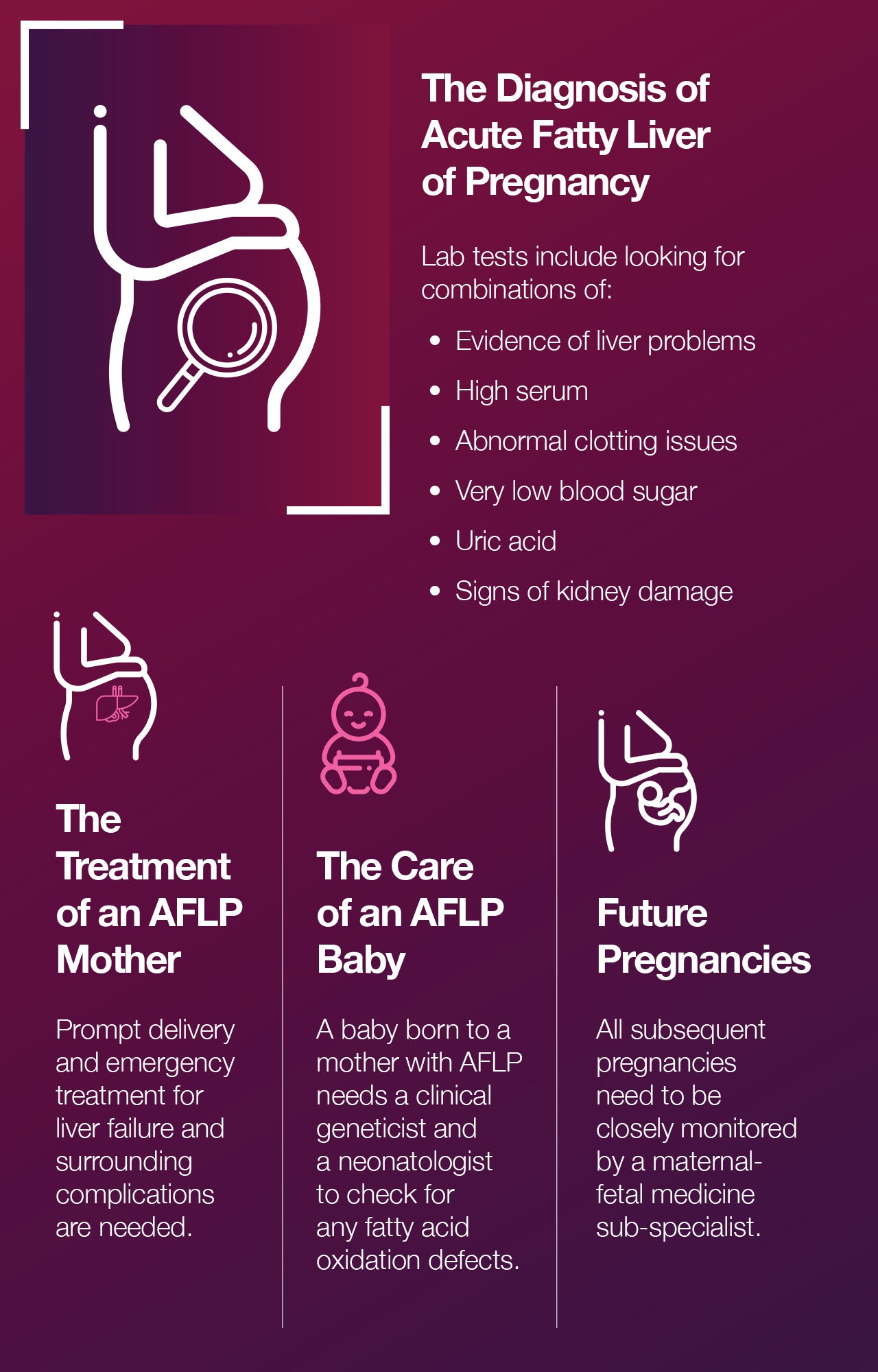Acute Fatty Liver of Pregnancy: How to Recognize Symptoms and Improve Outcomes
 By: by Amino Science
By: by Amino Science

Acute fatty liver of pregnancy (AFLP) is a rare disorder that occurs in the late-stage second and third trimester of pregnancy. It is a life-threatening but preventable cause of maternal mortality whose risk factors are better understood in gynecology and obstetrics every year. This article has the details of what causes this condition, the symptoms of AFLP, and how to improve maternal outcomes and fetal survival rates.
What Is Acute Fatty Liver of Pregnancy?
Though uncommon, acute fatty liver of pregnancy is particularly dangerous because its clinical presentation allows it to be misdiagnosed as other conditions like HELLP syndrome (hemolysis, elevated liver enzymes, low platelet count) and preeclampsia. In fact nearly half of AFLP cases are mistaken for preeclampsia, delaying treatment and increasing the risk to both mother and baby.
AFLP occurs in about 0.25% to 0.5% of U.S. pregnancies each year, and though physicians are not yet sure why, it more frequently involves twin pregnancies rather than single pregnancies, and male fetuses rather than female ones. Though "liver" is in the name, severe cases can come with multisystem involvement that includes acute renal failure, gastrointestinal bleeding, encephalopathy, coagulopathy, pancreatitis, and (more rarely) transient diabetes insipidus.
Women may have preeclampsia alongside AFLP, making both conditions harder to distinguish and treat, as researchers believe AFLP, preeclampsia, HELLP syndrome, and thrombotic thrombocytopenia purpura may all be "a spectrum of the same illness." AFLP is typically diagnosed later in pregnancies just before the time of delivery, but diagnosis may not happen until directly after delivery, when the proper aid is most critical.
What Is the Cause of AFLP?
Acute fatty liver of pregnancy is caused when either the mother or the baby has a genetic disorder affecting the mitochondrial beta-oxidation of fatty acids. In simpler terms, that means the mitochondria in their cells are not able to break down fatty acids into their smaller molecular components, leading to a dangerous accumulation of fat in the liver cells, kidney, placenta, or other areas.
If the buildup leads to an interruption in the mother's liver function, it puts both her and the fetus at risk; the liver removes toxins for both bodies, and the symptoms of dysfunction can be very slow and subtle in their development. This makes identifying the issue difficult for both the patient and her doctor.
Evolutionary Theories
While the exact reason acute fatty liver of pregnancy affects otherwise healthy women in the last stages before birth is unknown, researchers have theorized that it has to do with our evolution. In times of famine our bodies have mechanisms in place to allow us to switch from sugar energy (glucose) derived from carbohydrates to ketone energy sourced from our fat stores.
If you've ever heard of the ketogenic diet, it's built on this same premise: if you deny the body carb intake via dietary restriction, it will trigger this secondary metabolism and lead to rapid body fat loss. This metabolic pathway is not unique to humans. It's also what allows certain animals to hibernate all winter and migratory birds to cover long distances in nonstop flights.
During pregnancy, the mother's body starts utilizing stored fat for energy. Why this happens is unclear; it could be due to needing extra energy for the potentially long duration of labor, or it could be because the body is now prioritizing carbohydrate energy for the nutrition and growth of the fetus (or both). Whatever the exact biological stimulus behind it, fat is being burned in the late stages of pregnancy, and if there is a previously unknown genetic disorder that inhibits the breakdown of fat and leads to liver buildup of fat, acute fatty liver disease of pregnancy could be the result, leading potentially to liver failure and an increased fetal mortality rate. In the most severe cases, a new mother may need a liver transplantation due to fulminant hepatic failure, and the newborn baby may require monitoring in the neonatal intensive care unit (NICU) to survive.

Signs and Symptoms of Acute Fatty Liver of Pregnancy
The increase in energy demands during the late stages of pregnancy lead to a heavier reliance on fat for energy. Researchers theorize that this is why AFLP occurs more typically at the end of pregnancy.
Early diagnosis of AFLP is crucial, because while a liver biopsy showing microvesicular steatosis of hepatocytes makes a sure diagnosis, it is not safe for the patient to undergo in the late stages of pregnancy. Rather, the blood test differences between AFLP and HELLP and preeclampsia, while subtle, have been carefully differentiated so that a determination could be made on blood tests as soon as possible without need of biopsy.
As liver function is compromised, the patient begins to go from healthy to extremely sick. The most commonly associated symptoms of AFLP are:
- Loss of appetite
- Mental confusion
- Extreme sleepiness and fatigue
- Abdominal pain and specifically epigastric (upper right abdomen) distress
- Nausea or vomiting
- Jaundice (an advanced symptom)
As you can see, most of these symptoms could easily be attributed to the usual symptoms of pregnancy until suddenly a woman finds herself jaundiced and in extreme danger. In the most tragic cases, diagnosis is only made after the fetus has died in utero.
The Difference Between AFLP and HELLP Syndrome
Acute fatty liver of pregnancy is distinct from HELLP syndrome and various other preeclampsia conditions by its development. While the symptoms are similar, a lab test is able to verify the distinction between the abnormal clotting conditions associated with AFLP and the decreased platelet count of HELLP syndrome.
Other differences include these HELLP symptoms:
- Higher blood pressure
- No acidosis (acid buildup in the blood)
- No abnormality in blood glucose levels
- No sensorium changes or compromised brain function
- Normal uric acid levels
- Less severe results from liver function tests
Other distinctions include subtle indications, like AFLP is more commonly associated with compromised kidney function than HELLP syndrome is, AFLP has a greater likelihood of bilirubin increase in lab testing than HELLP syndrome does, and hypertension is less present in AFLP, but AFLP patients frequently have proteinuria (protein in the urine).

The Diagnosis of AFLP
The diagnosis of acute fatty liver of pregnancy based on the symptoms alone is almost impossible. Sometimes the condition is not discovered and diagnosed until such time as an emergency cesarean section is called for due to fetal distress. Lab tests include looking for combinations of:
- Evidence of liver problems
- High serum ammonia
- Abnormal clotting issues
- Very low blood sugar
- Uric acid
- Signs of kidney damage
Clinicians will also rule out any other potential causes of liver failure, including potential exposure to various forms of hepatitis in third-world endemic areas, drug-induced liver damage, malaria exposure, and potential acute viral hepatitis B infection.
The Treatment of an AFLP Mother
Currently the management strategies of this condition involve facilitating a prompt delivery (via cesarean section if necessary) of the infant and anticipating the potential complications of acute liver failure, including having the appropriate blood product and plasma exchange material on hand. The sooner this condition is recognized, the better prepared the medical team can be for quickly and effectively treating both mother and child.
Depending on the mother's condition after the placenta has been removed, she may need an enhanced level of postpartum care, including up to several weeks in an intensive care facility with round-the-clock multidisciplinary health care professionals (hepatology, obstetrics, hematology, anesthesia, and neonatology) to treat liver dysfunction and other related side effects.
Though it's an incredibly serious condition, most mothers with AFLP exhibit rapid improvement after delivery, with follow-up tests showing liver functions reverting to normal.
The Care of an AFLP Baby
The first step in caring for a baby born to a mother with AFLP is to assign the child to a clinical geneticist and a neonatologist to check for any fatty acid oxidation defects like LCHAD (long-chain 3-hydroxyacyl-coenzyme A dehydrogenase) deficiency. Between 15% and 20% of all AFLP pregnancies result in children with LCHAD deficiency.
Children with fatty acid oxidation defects can range anywhere from asymptomatic to severely compromised with cardiomyopathy or encephalopathy. The child could also suffer from sudden infant death. That is why immediate expert evaluation is required.
Newborns with medium-chain fatty acid oxidation defects are 12 times more likely to have maternal liver disease, while newborns with LCHAD defects are 50 times more likely. This analysis revealed that out of 63 pregnancies resulting in 28 LCHAD-deficient births, 31% of those were associated with AFLP, HELLP syndrome, and preeclampsia, while 10% were linked to intrahepatic cholestasis (a pregnancy-associated disorder that impairs bile release from the liver cells). No links were found in pregnancies that resulted in healthy births.
Children born to mothers with AFLP may carry the same genetic defect as the mother, and may be more at risk of nonketotic hypoglycemia (a life-threatening inherited condition that inhibits the breakdown of amino acids). Other AFLP children may have dilated cardiomyopathy (a serious condition that involves swelling in the heart chambers) or progressive neuropathy (a worsening nerve disorder). All babies and mothers who have experienced acute fatty liver of pregnancy require testing for short-, medium-, and long-chain abnormalities in relation to the mitochondrial beta-oxidation of fatty acids.
Future Pregnancies
Having survived acute fatty liver of pregnancy once, it's only reasonable to be concerned that this condition could affect you again. Unfortunately, there is no hard data on the exact likelihood of recurrence. Anyone who has undergone an AFLP pregnancy should be under the care of a maternal-fetal medicine sub-specialist for any future pregnancies, and should take special care to monitor for the symptoms of AFLP in all subsequent pregnancies.

AFLP Prognosis
Keep in mind that acute fatty liver of pregnancy is an incredibly rare condition worldwide. Nevertheless, because it's such a dangerous condition with so few identifying symptoms, the diagnostic criteria has been carefully honed to detect it as soon as possible to prevent maternal and fetal mortality rates. By increasing yours and others' awareness of this preventable cause of maternal mortality, you may help promote survival.
You can also help keep your liver healthy with essential amino acids, proven to help prevent and reverse fatty liver disease. Find out how, here.

Up to 25% off Amino
Shop NowTAGS: conditions
Join the Community
Comments (0)
Most Craveable Recipes




 833-264-6620
833-264-6620



















